fuses Peugeot 508 2020 Owner's Manual
[x] Cancel search | Manufacturer: PEUGEOT, Model Year: 2020, Model line: 508, Model: Peugeot 508 2020Pages: 276, PDF Size: 8.43 MB
Page 77 of 276
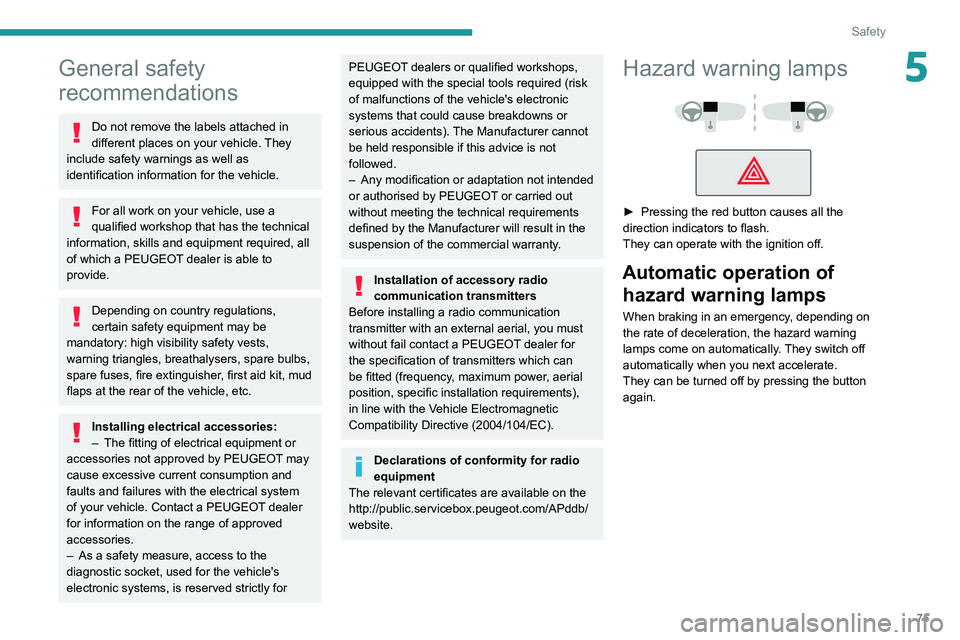
75
Safety
5General safety
recommendations
Do not remove the labels attached in
different places on your vehicle. They
include safety warnings as well as
identification information for the vehicle.
For all work on your vehicle, use a
qualified workshop that has the technical
information, skills and equipment required, all
of which a PEUGEOT dealer is able to
provide.
Depending on country regulations,
certain safety equipment may be
mandatory: high visibility safety vests,
warning triangles, breathalysers, spare bulbs,
spare fuses, fire extinguisher, first aid kit, mud
flaps at the rear of the vehicle, etc.
Installing electrical accessories:
– The fitting of electrical equipment or
accessories not approved by PEUGEOT
may
cause excessive current consumption and
faults and failures with the electrical system
of your vehicle. Contact a PEUGEOT dealer
for information on the range of approved
accessories.
–
As a safety measure, access to the
diagnostic socket, used for the vehicle's
electronic systems, is reserved strictly for
PEUGEOT dealers or qualified workshops,
equipped with the special tools required (risk
of malfunctions of the vehicle's electronic
systems that could cause breakdowns or
serious accidents). The Manufacturer cannot
be held responsible if this advice is not
followed.
–
Any modification or adaptation not intended
or authorised by PEUGEOT
or carried out
without meeting the technical requirements
defined by the Manufacturer will result in the
suspension of the commercial warranty.
Installation of accessory radio
communication transmitters
Before installing a radio communication
transmitter with an external aerial, you must
without fail contact a PEUGEOT dealer for
the specification of transmitters which can
be fitted (frequency, maximum power, aerial
position, specific installation requirements),
in line with the Vehicle Electromagnetic
Compatibility Directive (2004/104/EC).
Declarations of conformity for radio
equipment
The relevant certificates are available on the
http://public.servicebox.peugeot.com/APddb/
website.
Hazard warning lamps
► Pressing the red button causes all the
direction indicators to flash.
They can operate with the ignition off.
Automatic operation of hazard warning lamps
When braking in an emergency, depending on
the rate of deceleration, the hazard warning
lamps come on automatically. They switch off
automatically when you next accelerate.
They can be turned off by pressing the button
again.
Page 125 of 276

123
Driving
6Changing the programmed speed setting
with the Speed Limit Recognition and
Recommendation function
► Press 5 to accept the speed suggested by
the function on the instrument panel, then press
again to confirm.
To prevent sudden acceleration or deceleration of the vehicle, select a
speed setting relatively close to the vehicle's
current speed.
Changing the inter-vehicle distance
► Press 6 to display the distance setting
thresholds ("Distant", "Normal" or "Close"), then
press again to select a threshold.
After a few seconds, the option is accepted and
will be memorised when the ignition is switched
off.
Temporarily exceeding the speed setting
► Fully depress the accelerator pedal. Distance
monitoring and cruise control are deactivated
while acceleration is maintained. "Cruise control
suspended" is displayed.
Deactivating the system
► Turn the thumbwheel 1 upwards to the OFF
position.
Information displayed on
the instrument panel
The following information can be seen on the
instrument panel in "DRIVING" display mode.
7. Vehicle detected by the system (full symbol)
8. Cruise control active (colour not grey)
9. Speed setting value
10. Speed suggested by the Speed Limit
Recognition and Recommendation
11 . Vehicle held stationary (versions with
automatic gearbox)
12.Inter-vehicle distance setting
13. Position of the vehicle detected by the
system
Messages and alerts
To benefit from the following information on the
instrument panel, select the " DRIVING" display
mode.
The display of these messages or alerts is not sequential.
"Cruise control paused" or "Cruise control
suspended" following a brief acceleration
by the driver.
"Cruise control active", no vehicle
detected.
"Cruise control paused", vehicle detected.
"Cruise control active", vehicle detected.
"Take back control" (orange).
►
Brake or accelerate, depending on the
context.
"Take back control" (red).
►
T
ake back control of the vehicle
immediately: the system cannot manage the
current driving situation.
"Activation not possible, conditions
unsuitable". The system refuses to
activate cruise control, as the necessary
conditions are not fulfilled.
Stop function
"Cruise control paused" (for a few
seconds).
Page 166 of 276
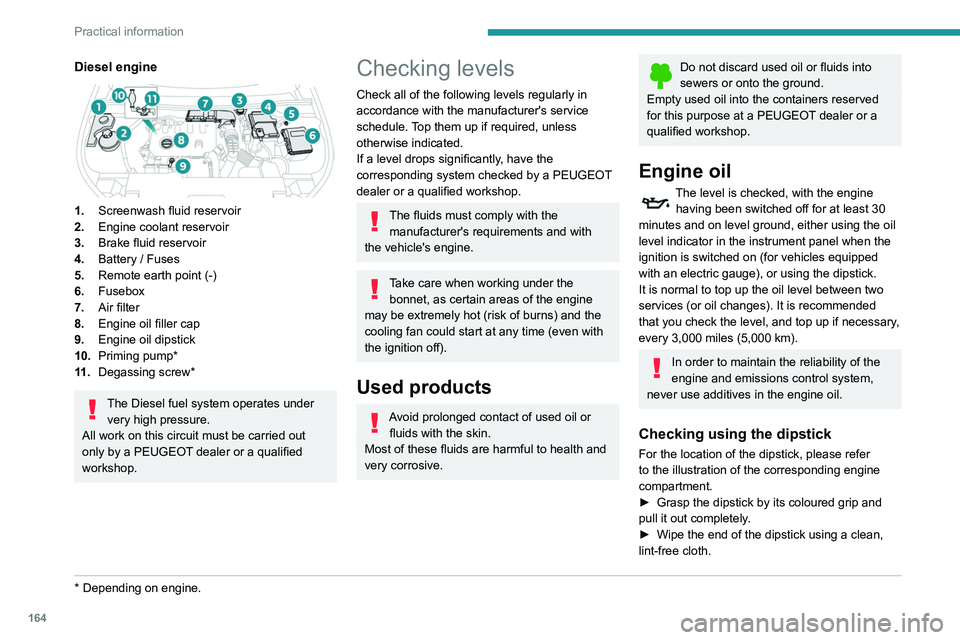
164
Practical information
Diesel engine
1.Screenwash fluid reservoir
2. Engine coolant reservoir
3. Brake fluid reservoir
4. Battery / Fuses
5. Remote earth point (-)
6. Fusebox
7. Air filter
8. Engine oil filler cap
9. Engine oil dipstick
10. Priming pump*
11 . Degassing screw*
The Diesel fuel system operates under
very high pressure.
All work on this circuit must be carried out
only by a PEUGEOT dealer or a qualified
workshop.
* Depending on engine.
Checking levels
Check all of the following levels regularly in
accordance with the manufacturer's service
schedule. Top them up if required, unless
otherwise indicated.
If a level drops significantly, have the
corresponding system checked by a PEUGEOT
dealer or a qualified workshop.
The fluids must comply with the manufacturer's requirements and with
the vehicle's engine.
Take care when working under the bonnet, as certain areas of the engine
may be extremely hot (risk of burns) and the
cooling fan could start at any time (even with
the ignition off).
Used products
Avoid prolonged contact of used oil or fluids with the skin.
Most of these fluids are harmful to health and
very corrosive.
Do not discard used oil or fluids into
sewers or onto the ground.
Empty used oil into the containers reserved
for this purpose at a PEUGEOT dealer or a
qualified workshop.
Engine oil
The level is checked, with the engine having been switched off for at least 30
minutes and on level ground, either using the oil
level indicator in the instrument panel when the
ignition is switched on (for vehicles equipped
with an electric gauge), or using the dipstick.
It is normal to top up the oil level between two
services (or oil changes). It is recommended
that you check the level, and top up if necessary,
every 3,000 miles (5,000 km).
In order to maintain the reliability of the
engine and emissions control system,
never use additives in the engine oil.
Checking using the dipstick
For the location of the dipstick, please refer
to the illustration of the corresponding engine
compartment.
►
Grasp the dipstick by its coloured grip and
pull it out completely
.
►
Wipe the end of the dipstick using a clean,
lint-free cloth.
► Reinsert the dipstick and push fully down,
then pull it out again to visually check the oil
level: the correct level is between marks A (max)
and B (min).
Do not start the engine if the level is:
– above mark A: contact a PEUGEOT dealer or
a qualified workshop.
– below mark B: top up the engine oil
immediately.
Oil grade
Before topping up or changing the engine
oil, check that the oil is suitable for the engine
and complies with the recommendations in
the service schedule supplied with the vehicle
(or available from your PEUGEOT dealer and
qualified workshops).
Use of non-recommended oil may invalidate
the contractual warranty in the event of
engine failure.
Topping up the engine oil level
For the location of the engine oil filler cap, please
refer to the corresponding under-bonnet engine
compartment illustration.
Page 186 of 276
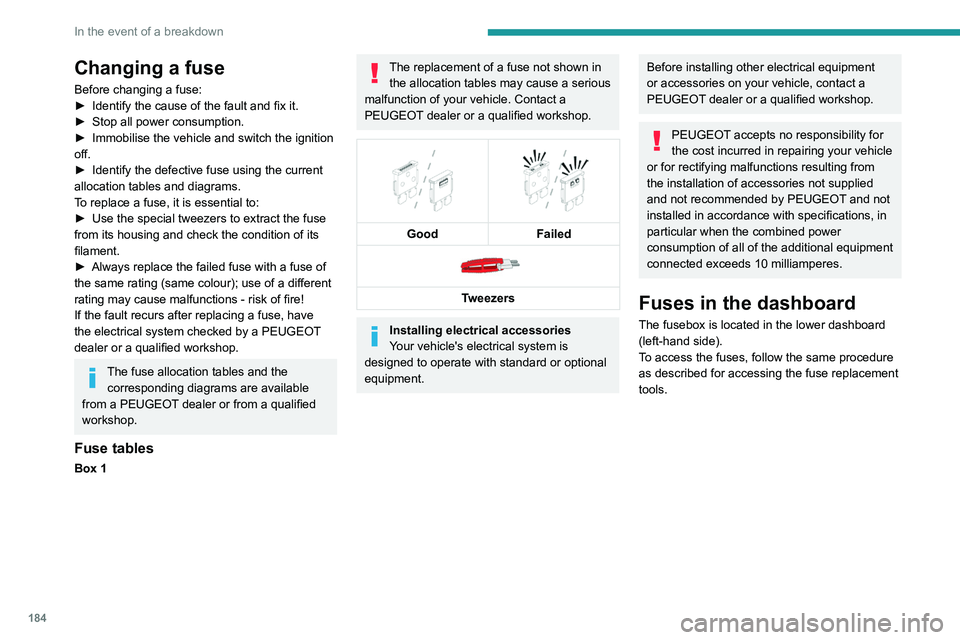
184
In the event of a breakdown
Changing a fuse
Before changing a fuse:
► Identify the cause of the fault and fix it.
►
Stop all power consumption.
►
Immobilise the vehicle and switch the ignition
off.
►
Identify the defective fuse using the current
allocation tables and diagrams.
T
o replace a fuse, it is essential to:
►
Use the special tweezers to extract the fuse
from its housing and check the condition of its
filament.
►
Always replace the failed fuse with a fuse of
the same rating (same colour); use of a different
rating may cause malfunctions - risk of fire!
If the fault recurs after replacing a fuse, have
the electrical system checked by a PEUGEOT
dealer or a qualified workshop.
The fuse allocation tables and the corresponding diagrams are available
from a PEUGEOT dealer or from a qualified
workshop.
The replacement of a fuse not shown in the allocation tables may cause a serious
malfunction of your vehicle. Contact a
PEUGEOT dealer or a qualified workshop.
Good
Failed
Tweezers
Installing electrical accessories
Your vehicle's electrical system is
designed to operate with standard or optional
equipment.
Before installing other electrical equipment
or accessories on your vehicle, contact a
PEUGEOT dealer or a qualified workshop.
PEUGEOT accepts no responsibility for
the cost incurred in repairing your vehicle
or for rectifying malfunctions resulting from
the installation of accessories not supplied
and not recommended by PEUGEOT and not
installed in accordance with specifications, in
particular when the combined power
consumption of all of the additional equipment
connected exceeds 10 milliamperes.
Fuses in the dashboard
The fusebox is located in the lower dashboard
(left-hand side).
To access the fuses, follow the same procedure
as described for accessing the fuse replacement
tools.
Fuse tables
Box 1
Page 189 of 276

187
In the event of a breakdown
8Fuse N°Rating (A)Functions
F36 30 APanoramic sunroof.
F37 30 APanoramic sunroof blind.
F38 30 AElectric seats.
F39 30 AMotorised tailgate unit.
F40 25 AAdditional heating.
Trailer interface unit
Fuse N° Rating (A)Functions
F36 20 ABrake lamps - Reversing lamps (trailer).
F37 20 ASidelamps - Direction indicators (trailer).
F38 20 AInterior lighting (caravan).
F40 2 AAudible signal (trailer).
Engine compartment fuses
The fusebox is placed in the engine
compartment near the battery.
Page 190 of 276
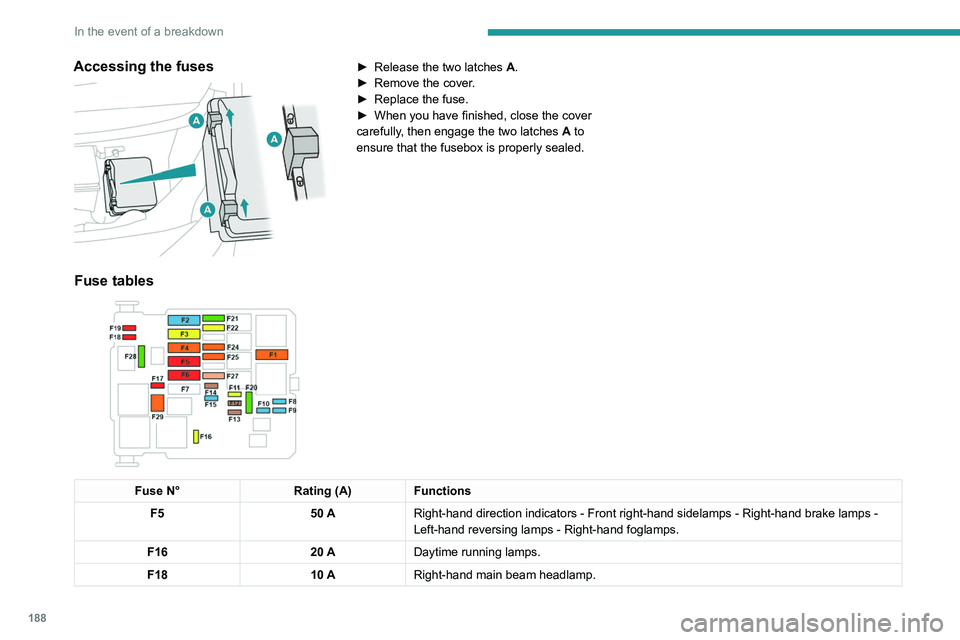
188
In the event of a breakdown
Accessing the fuses
► Release the two latches A .
► Remove the cover .
►
Replace the fuse.
►
When you have finished, close the cover
carefully
, then engage the two latches A
to
ensure that the fusebox is properly sealed.
Fuse tables
Fuse N° Rating (A)Functions
F5 50 ARight-hand direction indicators - Front right-hand sidelamps - Right-han\
d brake lamps -
Left-hand reversing lamps - Right-hand foglamps.
F16 20 ADaytime running lamps.
F18 10 ARight-hand main beam headlamp.
Page 248 of 276
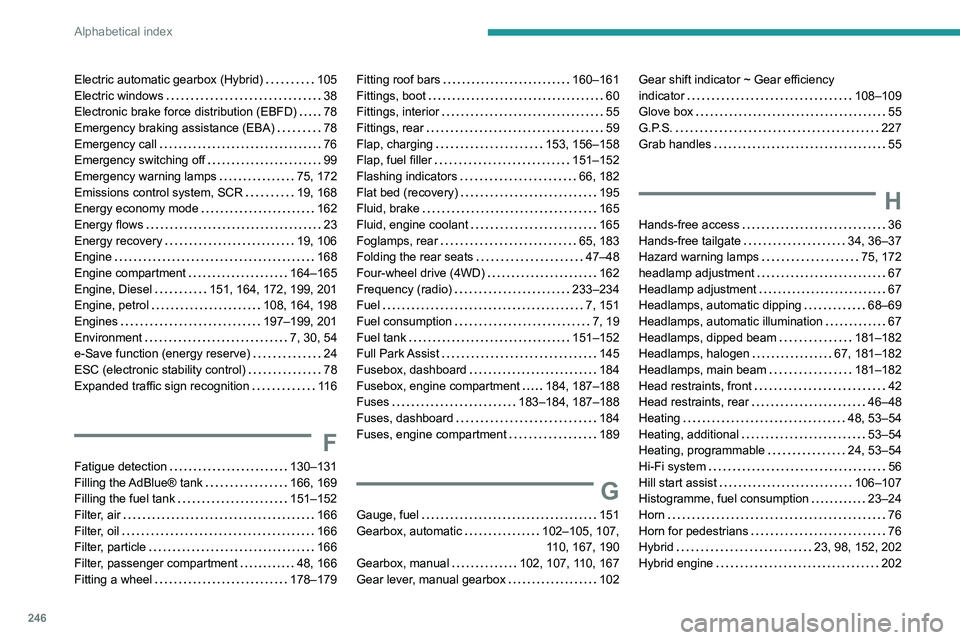
246
Alphabetical index
Electric automatic gearbox (Hybrid) 105
Electric windows
38
Electronic brake force distribution (EBFD)
78
Emergency braking assistance (EBA)
78
Emergency call
76
Emergency switching off
99
Emergency warning lamps
75, 172
Emissions control system, SCR
19, 168
Energy economy mode
162
Energy flows
23
Energy recovery
19, 106
Engine
168
Engine compartment
164–165
Engine, Diesel
151, 164, 172, 199, 201
Engine, petrol
108, 164, 198
Engines
197–199, 201
Environment
7, 30, 54
e-Save function (energy reserve)
24
ESC (electronic stability control)
78
Expanded traffic sign recognition
11 6
F
Fatigue detection 130–131
Filling the AdBlue® tank
166, 169
Filling the fuel tank
151–152
Filter, air
166
Filter, oil
166
Filter, particle
166
Filter, passenger compartment
48, 166
Fitting a wheel
178–179
Fitting roof bars 160–161
Fittings, boot
60
Fittings, interior
55
Fittings, rear
59
Flap, charging
153, 156–158
Flap, fuel filler
151–152
Flashing indicators
66, 182
Flat bed (recovery)
195
Fluid, brake
165
Fluid, engine coolant
165
Foglamps, rear
65, 183
Folding the rear seats
47–48
Four-wheel drive (4WD)
162
Frequency (radio)
233–234
Fuel
7, 151
Fuel consumption
7, 19
Fuel tank
151–152
Full Park Assist
145
Fusebox, dashboard
184
Fusebox, engine compartment
184, 187–188
Fuses
183–184, 187–188
Fuses, dashboard
184
Fuses, engine compartment
189
G
Gauge, fuel 151
Gearbox, automatic
102–105, 107, 110, 167, 190
Gearbox, manual
102, 107, 110, 167
Gear lever, manual gearbox
102
Gear shift indicator ~ Gear efficiency
indicator
108–109
Glove box
55
G.P.S.
227
Grab handles
55
H
Hands-free access 36
Hands-free tailgate
34, 36–37
Hazard warning lamps
75, 172
headlamp adjustment
67
Headlamp adjustment
67
Headlamps, automatic dipping
68–69
Headlamps, automatic illumination
67
Headlamps, dipped beam
181–182
Headlamps, halogen
67, 181–182
Headlamps, main beam
181–182
Head restraints, front
42
Head restraints, rear
46–48
Heating
48, 53–54
Heating, additional
53–54
Heating, programmable
24, 53–54
Hi-Fi system
56
Hill start assist
106–107
Histogramme, fuel consumption
23–24
Horn
76
Horn for pedestrians
76
Hybrid
23, 98, 152, 202
Hybrid engine
202
Page 250 of 276
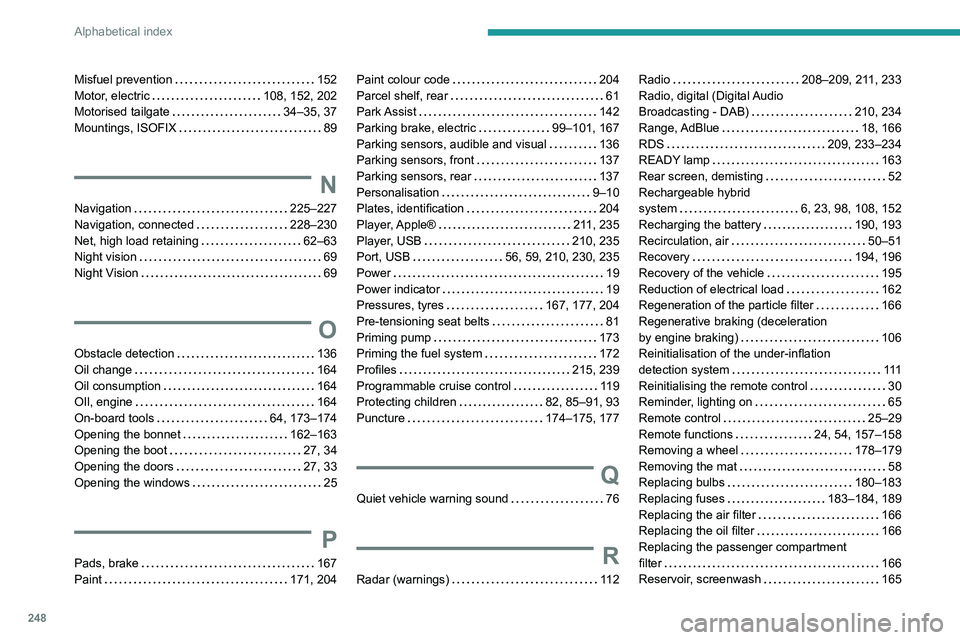
248
Alphabetical index
Misfuel prevention 152
Motor, electric
108, 152, 202
Motorised tailgate
34–35, 37
Mountings, ISOFIX
89
N
Navigation 225–227
Navigation, connected
228–230
Net, high load retaining
62–63
Night vision
69
Night Vision
69
O
Obstacle detection 136
Oil change
164
Oil consumption
164
OIl, engine
164
On-board tools
64, 173–174
Opening the bonnet
162–163
Opening the boot
27, 34
Opening the doors
27, 33
Opening the windows
25
P
Pads, brake 167
Paint
171, 204
Paint colour code 204
Parcel shelf, rear
61
Park Assist
142
Parking brake, electric
99–101, 167
Parking sensors, audible and visual
136
Parking sensors, front
137
Parking sensors, rear
137
Personalisation
9–10
Plates, identification
204
Player, Apple®
211, 235
Player, USB
210, 235
Port, USB
56, 59, 210, 230, 235
Power
19
Power indicator
19
Pressures, tyres
167, 177, 204
Pre-tensioning seat belts
81
Priming pump
173
Priming the fuel system
172
Profiles
215, 239
Programmable cruise control
119
Protecting children
82, 85–91, 93
Puncture
174–175, 177
Q
Quiet vehicle warning sound 76
R
Radar (warnings) 11 2
Radio 208–209, 211, 233
Radio, digital (Digital Audio
Broadcasting - DAB)
210, 234
Range, AdBlue
18, 166
RDS
209, 233–234
READY lamp
163
Rear screen, demisting
52
Rechargeable hybrid
system
6, 23, 98, 108, 152
Recharging the battery
190, 193
Recirculation, air
50–51
Recovery
194, 196
Recovery of the vehicle
195
Reduction of electrical load
162
Regeneration of the particle filter
166
Regenerative braking (deceleration
by engine braking)
106
Reinitialisation of the under-inflation
detection system
111
Reinitialising the remote control
30
Reminder, lighting on
65
Remote control
25–29
Remote functions
24, 54, 157–158
Removing a wheel
178–179
Removing the mat
58
Replacing bulbs
180–183
Replacing fuses
183–184, 189
Replacing the air filter
166
Replacing the oil filter
166
Replacing the passenger compartment
filter
166
Reservoir, screenwash
165
Page 251 of 276
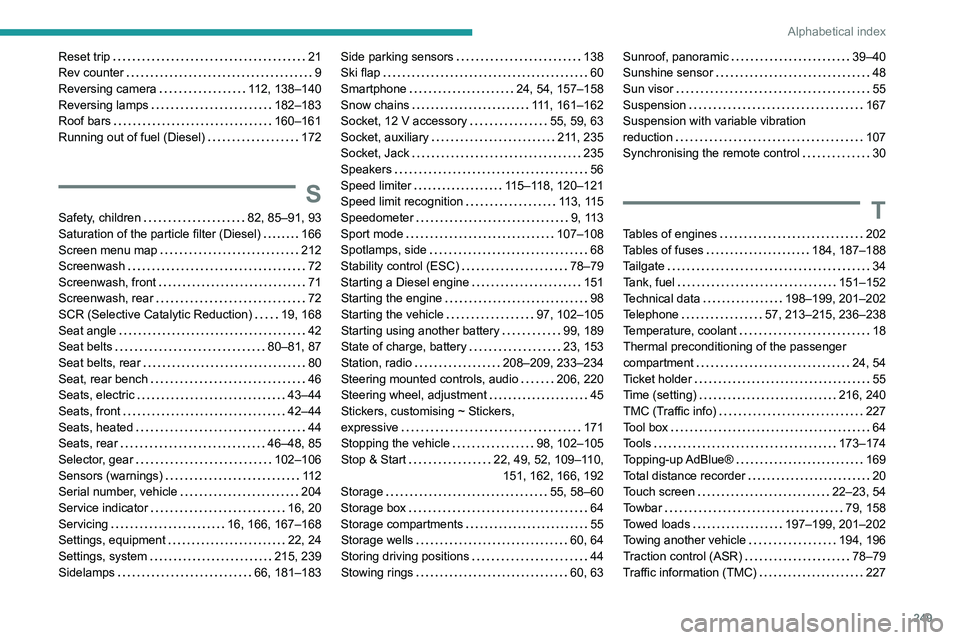
249
Alphabetical index
Reset trip 21
Rev counter
9
Reversing camera
112, 138–140
Reversing lamps
182–183
Roof bars
160–161
Running out of fuel (Diesel)
172
S
Safety, children 82, 85–91, 93
Saturation of the particle filter (Diesel)
166
Screen menu map
212
Screenwash
72
Screenwash, front
71
Screenwash, rear
72
SCR (Selective Catalytic Reduction)
19, 168
Seat angle
42
Seat belts
80–81, 87
Seat belts, rear
80
Seat, rear bench
46
Seats, electric
43–44
Seats, front
42–44
Seats, heated
44
Seats, rear
46–48, 85
Selector, gear
102–106
Sensors (warnings)
11 2
Serial number, vehicle
204
Service indicator
16, 20
Servicing
16, 166, 167–168
Settings, equipment
22, 24
Settings, system
215, 239
Sidelamps
66, 181–183
Side parking sensors 138
Ski flap
60
Smartphone
24, 54, 157–158
Snow chains
111, 161–162
Socket, 12 V accessory
55, 59, 63
Socket, auxiliary
211, 235
Socket, Jack
235
Speakers
56
Speed limiter
115–118, 120–121
Speed limit recognition
113, 115
Speedometer
9, 113
Sport mode
107–108
Spotlamps, side
68
Stability control (ESC)
78–79
Starting a Diesel engine
151
Starting the engine
98
Starting the vehicle
97, 102–105
Starting using another battery
99, 189
State of charge, battery
23, 153
Station, radio
208–209, 233–234
Steering mounted controls, audio
206, 220
Steering wheel, adjustment
45
Stickers, customising ~ Stickers,
expressive
171
Stopping the vehicle
98, 102–105
Stop & Start
22, 49, 52, 109–110,
151, 162, 166, 192
Storage
55, 58–60
Storage box
64
Storage compartments
55
Storage wells
60, 64
Storing driving positions
44
Stowing rings
60, 63Sunroof, panoramic 39–40
Sunshine sensor
48
Sun visor
55
Suspension
167
Suspension with variable vibration
reduction
107
Synchronising the remote control
30
T
Tables of engines 202
Tables of fuses
184, 187–188
Tailgate
34
Tank, fuel
151–152
Technical data
198–199, 201–202
Telephone
57, 213–215, 236–238
Temperature, coolant
18
Thermal preconditioning of the passenger
compartment
24, 54
Ticket holder
55
Time (setting)
216, 240
TMC (Traffic info)
227
Tool box
64
Tools
173–174
Topping-up AdBlue®
169
Total distance recorder
20
Touch screen
22–23, 54
Towbar
79, 158
Towed loads
197–199, 201–202
Towing another vehicle
194, 196
Traction control (ASR)
78–79
Traffic information (TMC)
227